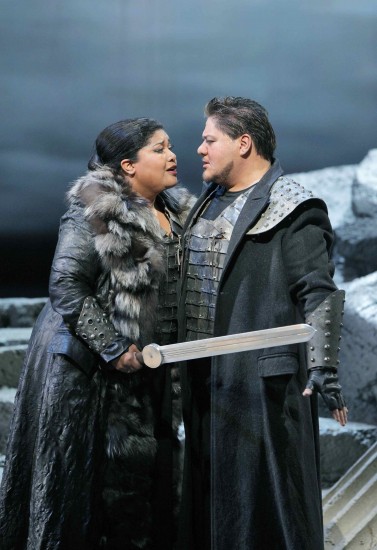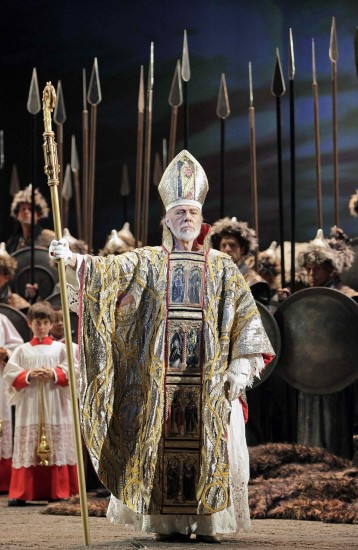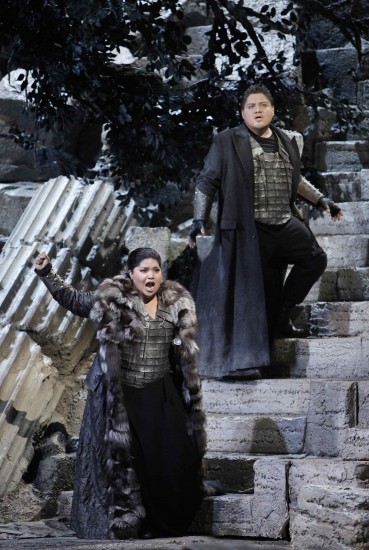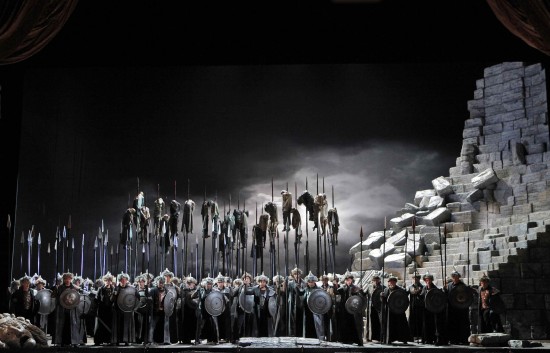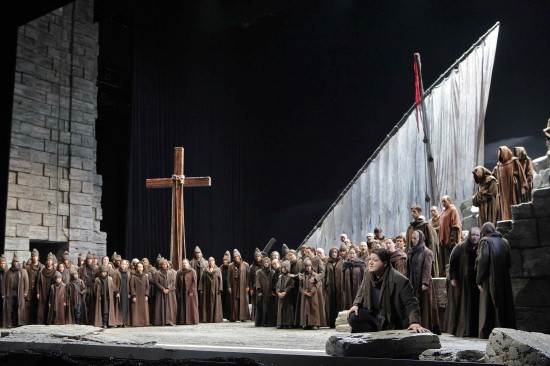Any way you look at it, Attila is not your usual opera.
To begin with, there is only one woman principal in the cast – but what a woman! Her first appearance is as a captured female warrior.
Attila (Ferruccio Furlanetto) is impressed by her bravery and asks what can I do to make your stay with me more enjoyable. “Give me back my sword,” quoth Odabella (Lucrecia Garcia) whose father, a Lord from Aquileia had been killed by Attila. “Here, take mine,” Attila says, offering his mighty sword. She accepts with an aside to the effect that she plans to return it – point first.
Offhand, I can’t think of any other grand opera in which the leading lady neither dies nor nestles happily in the arms of the leading man (usually a tenor), but here the leading man is a bass and she kills him.
Odabella’s lover Foresto (Diego Torre) a knight of Aquileia, however is a typical operatic tenor: marvelous voice, insanely jealous, and not the brightest kid on the block.
The three supporting roles are all worth mentioning. Quinn Kelsey displays a powerful bass-baritone voice as the Roman general Ezio, and I have no complaints about Nathaniel Peake as Uldino, Attila’s personal slave.
Last but not least, as they say, was the legendary Samuel Ramey in the bit role of Pope Leo I. His voice isn’t all that it used to be, but the obvious quaver in it is entirely appropriate if we make the reasonable assumption that the Pope is an old man. Some trivia: 21 years ago (the only previous time that San Francisco Opera mounted Attila) Ramey sang the title role. And much further back, it was his performance in the title role of Boito’s Mefistofeles that changed my personal approach to opera from “It’s OK, but I can take it or leave it,” to “Hey, this opera stuff really has something!”
As is usually the case with San Francisco Opera, the choral work was excellent – both the 60-voiced regular chorus led by Ian Robertson and the 16 members of the San Francisco Girls Chorus, led by Brandon Brack and Elizabeth Avakian. And, of course, Maestro Nicola Luisotti held it all together.
That’s the good news. The bad news is the acting. Not that the acting was bad – just that the acting wasn’t. The characters on stage pretty much ignored each other and sang directly to the audience. Was Director Gabriele Lavia deliberately trying to bring back the old days when opera was to be heard and not seen?
Before pursuing that question, let’s talk about the sets. That is one area in which the big opera companies such as San Francisco and New York have it all over small ones. With their gigantic stages and gigantic budgets, they can produce sets that my favorite small companies such as West Bay and Pocket Opera should not even dream of. Set Designer Alessandro Camera did not disappoint. The prologue is set in a square in the ruined town of Aquileia and features a towering flight of crumbling stone steps littered with debris including a fallen stone column.
A later scene takes place in Venice. The rear of the stage features a multi-story somewhat dilapidated triangular sail. The final act is set in the ruins of a modern cinema (!) (more on that later) and all entrances and exits are made through a tear in the bottom of a gigantic movie screen.
Back to the directing. In a fascinating double interview in the opera program Conductor Nicola Luisotti says, “� ambiguity exists because the enemy, Attila, represented the Austrians who occupied Northern Italy in the nineteenth century�. Thus Odabella cuts off Attila’s head in order to free her land�. Her actions are a metaphor for Italy’s long battle for freedom.”
Gabriele Lavia continues, “I thought that it would be interesting visually to tell the story through different historical moments�. First, there is Attila’s historical time (fifth century); then Verdi’s historical time (mid-nineteenth century); and finally our own contemporary age. In the third act, these periods � bring to light a sense of freedom � and a sense of rebellion against the invader and destroyer�. First we have the ruins of a Roman amphitheater, then a nineteenth-century theater, and finally a � movie theater in ruins.”
A worthy goal. Unfortunately, in the quest for it, Lavia lost track of the primary job of a director: tell the story in action that the composer and librettist are telling in music and words; enhance it if you can, but do not distract from it. The fifth-century amphitheater was fine,

Nathaniel Peake (Uldino), Diego Torre (Foresto), Lucrecia Garcia (Odabella), Quinn Kelsey (Ezio) and Ferruccio Furlanetto (Attila) in Act II of Attila.
but the sudden appearance of opera boxes filled with impeccably dressed men and women at a battle-field feast served on a linen-covered table laid with crystal wine goblets was incongruous, to say the least. I found it quite distracting.
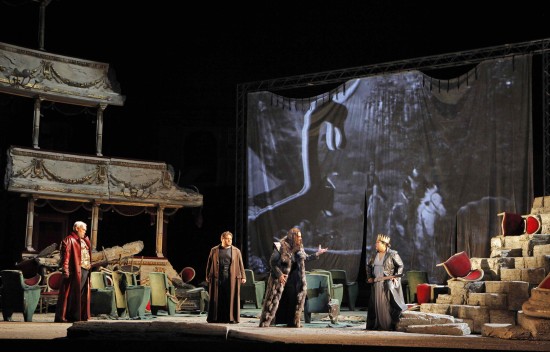
Quinn Kelsey (Ezio), Diego Torre (Foresto), Ferruccio Furlanetto (Attila) and Lucrecia Garcia (Odabella) in Act III of Attila
The tattered movie screen for entrances was effective, but seeing partially translucent images of old Hollywood Attila movies on it was extremely distracting as the opera plot was reaching its dramatic climax.
There are still several performances before Verdi’s Attila closes with a July 1 Matinee (for detailed information and to buy tickets go to sfopera.com). If you are already thoroughly familiar with Verdi’s masterpieces by all means, broaden your experiences by seeing Attila. But if you’re still getting acquainted with the Master, wait until September 7 when the 2012-13 season opens with his Rigoletto.
San Francisco Opera
301 Van Ness Avenue
San Francisco, CA 94102
(415) 861-4008
sfopera.com
All photos by Cory Weaver, San Francisco Opera
This review by Philip G Hodge appeared in sanfranciscosplash.com on June 27, 2012.



